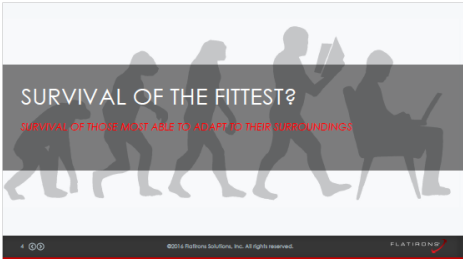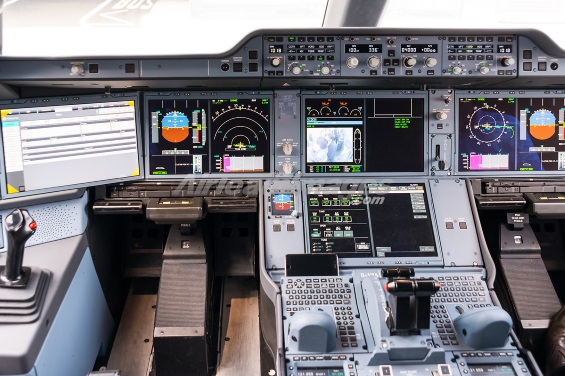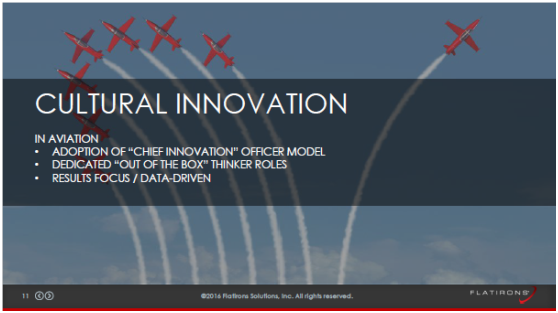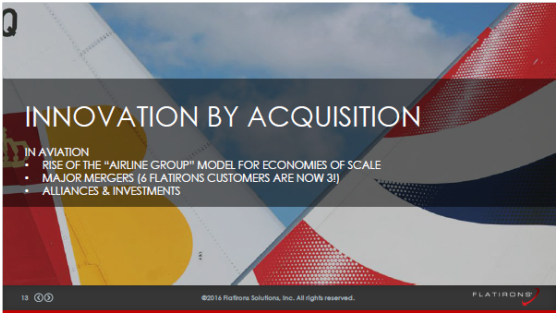Articles
| Name | Author | |
|---|---|---|
| CMS Integration with M&E Systems | Thanos Kaponeridis, President & CEO, AeroSoft Systems | View article |
| MRO Technology Innovations: using BOTS and HoloLens to change the way work is done | Arun Navneethakrishnan, Solution Advisory, Americas, Ramco Systems | View article |
| Aviation maintenance, the imperative to innovate | Wayne Enis, Director of Sales Engineering at Flatirons Solutions | View article |
| Tail planning to stay ahead of schedule | Andrew Stimpson, Solution Manager, Middle East, IFS | View article |
Aviation maintenance, the imperative to innovate
Author: Wayne Enis, Director of Sales Engineering at Flatirons Solutions
SubscribeAviation maintenance, the imperative to innovate

The complexity of new generation fleets and increased global competition, says Wayne Enis, Director of Sales Engineering at Flatirons Solutions, make innovation a requirement
In this article, I want to talk about innovation; what it is and why we do it. Everybody understands the need to innovate but we don’t always understand why; the rational that drives innovation. And, of equal importance, what happens if there is no innovation. Putting it simply, innovation is about survival of the fittest or, in terms more tuned to the commercial aviation market, survival of those best equipped and most able to adapt to their surroundings.

It comes to Darwinism; the need to survive (and thrive) is at the crux of why we must innovate. Readers are in business to make money and hopefully to enjoy making money doing what they love doing; however, it’s ultimately about making sure that the business is viable.
KEY REASONS TO EMBRACE INNOVATION
There are a number of strategic reasons why software vendors, airlines or any business should innovate if they want to survive: but really there are three or four key reasons why a software vendor or an airline would need to innovate. Reasons that have emerged over the past five or ten years and will only become more important as we proceed through the next few years.
Next generation aircraft
The first reason to innovate is the arrival of new generation fleets: many readers’ airlines will either already be operating or will have on order Boeing 787 or Airbus A350 fleets. These aircraft are delivered with new systems built in. They’re e-enabled from the outset – indeed you might describe them as huge data producing computers that happen also to fly and transport passengers and cargo from place to place. The amount of data these aircraft are generating is immense and on a scale out of proportion to that produced by legacy types. Also, these new generation aircraft could be said to be prognostics powered, with systems that try to work out when things will fail and then integrate that information with the adaptive maintenance side of the business. New generation aircraft are the biggest drivers of innovation in the airline industry. A feature of aviation has always been that for most of the time there have been relatively small incremental innovations when needed but there are also points in time when there is a big shift, a step change. That big shift is what we’re seeing with the 787 and A350: the fact that they have a lot of composites in their structures shows how innovative their engineering has been. But it’s that data generation capacity that—for airlines adopting new generation fleets and software vendors striving to meet their needs—makes these aircraft big drivers for innovation.
Increased Competition
For airlines, the next big innovation driver has been increased competition. If we look at the way that airlines have evolved in recent years, the new airlines opening up in growth regions like the Middle East, Asia, China and India are introducing new services and products with which some of the older legacy carriers struggle to compete. Also, airlines in places like China are striving to find a model that will distinguish them from European, America and other traditional western carriers. A number of low-cost disrupters have entered the market and are looking at the low cost carriers around Europe, America and Australia – they all focus on trying to come up with something new in the market, another type of innovation that is starting to appear in this industry. And, of course, there is the phenomenon of consolidation. In the USA, the six major carriers of a few years ago have now merged down to three huge businesses. This drives competition as they endeavor to leverage the most benefit and return from the new size, and innovation as they find new ways to exploit their even greater size and scope.
Market volatility
Another big driver of innovation is volatility. One thing of which our customers are aware at the moment is volatility in the fuel process. In most cases that might be positive if it drives down the costs of operations and ticket prices but the other side of that coin, if, say, a carrier has previously flown a lot oil executives flying first and business class, is that they will notice the oil and gas sector is currently struggling to meet the price points in those premium service seats. Things are often not as simple as they might first appear. Also, asset costs are rising in real terms. Looking at the costs of aircraft and engines over the last few years, some studies suggest significant increases. For instance, when the RB211 was introduced into service in the late 1960s early 1970s, it was a quarter of a million dollar engine which would translate to two or three million dollars in today’s prices. However, the Trent 900 which performs a similar role on a jumbo jet can range in price from $12million for one engine to $42million if services are included. The cost of these assets has risen by factors way in excess of retail price inflation. And finally, looking from a volatility perspective, is political and economic disruption which has been a feature of 2016. In the UK, the decision to leave the European Union (EU), so-called ‘Brexit’, has introduced economic uncertainty for both the UK itself and its partner countries in Europe. Airlines, more than most businesses, rely on the ability to trade in different geographic markets. So just that uncertainty of how the likes of British Airways, easyJet and other UK based carriers will be able to operate in the next few years is a significant driver of volatility.
There are plenty of reasons why airlines should innovate as part of their business process. The next question has to be how to bring that innovation into the business, what mechanisms can be used to create conditions in which innovation becomes a natural and native feature of the business.
ADDRESSING THE INNOVATION IMPERATIVE – STRATEGIES FOR SUCCESS
Incremental innovation
Let’s start with those constant changes that emanate from the natural life of an airline. As new aircraft, new engines and new components are introduced into service, they bring with them the latest technological developments and, more importantly in the context of innovation, the opportunities to innovate that are generated by those developments. We mentioned earlier the next generation aircraft, such as the 787 and A350, they represent a huge step change in technology and capability. In particular, the constant and huge flows of data from the aircraft that software vendors are just beginning to exploit in all areas of airline operations. From predictive (even prescriptive) maintenance to fuel management and customer services, the ‘big data’ flows from new generation aircraft are suggesting ideas for innovation and equipping airlines with a whole new toolbox with which to effect innovations that might previously have seemed mere pipedreams.

The reality of change is a constant element in any part of an airline but the sensible thing is to embrace change, harness its energy and exploit the new possibilities that it creates. Tie that to our natural tendency to learn from experience and you’ll get the adaptation of business models to match new conditions and leverage new opportunities with new pricing models or, perhaps new routes. It is the ability to initiate innovations like these that will distinguish the successful airlines from the rest. And, along with this, product offers should always be subject to scrutiny to ensure that they meet the needs of the market today: product innovation is an asset to any business.


In Flatirons Solutions, we have embraced the principle of incremental innovation in several significant ways. Over twenty years, we have seen the delivery of information progress from print (heavy to carry, cumbersome to update or edit, time consuming to use) through CD-ROM and then the Web to the current mobile capabilities—delivering the information needed for the task to the person who can do the task at the right time and wherever they are on any platform or any device in real-time or near real-time. In a similar way, products have developed to match the needs of businesses—often to pre-empt those changing needs. Next generation products such as, in the case of Flatirons Solutions, Knowledge Center 7, Pinpoint 7 and Pinpoint Mobile did not spring fully formed into the workplace, they are the result of consistent innovations over many years and decades, to match the innovations in the processes and products they serve. Also, as the way businesses are run has changed, with services such as outsourcing and BPO (business process outsourcing) enabling businesses to concentrate their resources on their core capabilities, so a business like Flatirons Solutions has expanded the range of its offers to include these innovative models.
Cultural innovation
The way businesses are structured is always changing and those changes are often cultural innovations in the business to reflect the operational innovations covered above. It might be that, in the past, things happened slowly and innovation was an unhurried, organic, reactive thing but, given the sort of powerful drivers that now generate the innovation imperative, businesses, including airlines, need to adopt a more rapid and proactive approach to innovation. This might mean adopting the Chief Innovation Officer model with innovation elevated to the status of key business activity to be proactively pursued rather than as a spin-off from other key activities or simple good luck. A business that seeks to always be ahead of the herd will create roles whose purpose is dedicated ‘out of the box’ thinking; always seeing where the business could better leverage its capabilities to gain an advantage. But, in all of this, businesses should never lose sight of the basic principles of focusing on results and, in the new generation business environment, being data driven: the two really go hand in hand.

We have embraced this new thinking at Flatirons Solutions, developing not just solutions for jobs but whole solution management models to help users derive the greatest value from their data and information. Like any business that wants to stay ahead, we invest significant amounts of money on R&D spending – nearly 15% of our gross revenue – and we also focus on incubating new ideas, bringing them to fruition in an environment conducive to innovation. Recently, we’ve embraced and advanced new technologies such as: the adoption of on- and off-line mobile technologies for more flexible information access, the use of paper-less options for task sign-off, and automated reporting against a wide range of compliance requirements using the power of XML.
As Flatirons looks toward the future, our innovation efforts are increasingly focused on initiatives that include leveraging the promise of telepresence to help maintainers and operators collaborate more efficiently across distributed geographies. Incubation efforts are also targeting the use of augmented and virtual reality to shorten task times and improve performance.
Innovation by acquisition
We’ve already looked at mergers and take-overs above but there is an innovative approach even to this corporate growth model. Rather than simply merge two brands into a new composite brand, or take-over another brand and have to launch the ‘acquiring’ brand in the ‘acquired’ market, a new model of airline groups is leveraging the benefits of scale while continuing to exploit brand awareness and loyalties won over many years by the group members. This is effective where groups serve more than one national market. So, rather than merge British Airways, Iberia, Aer Lingus and Vueling into either a single amorphous trans-national brand or lose three of the brands, International Airlines Group owns all four carriers to enjoy the cost advantages of being one of the world’s largest airline groups while retaining the brand loyalties and goodwill of the three national flag carriers in the group. In the single market that is the USA, the approach has been to take what were the ‘big six’ carriers and, through mergers, reduce these to three. Also, to an increasing degree across the airline industry, carriers are making alliances and investments in joint operations (such as engine overhaul facilities) to enjoy the benefits of scale without losing the advantages of brand and without compromising corporate independence.

Looking at our own business, Flatirons Solutions has never been afraid to acquire a capability, from the original Techpubs Global to Corena SAS, which would complement and enhance the overall offer of the business. Of course, just buying a business will not be enough: it’s important to both integrate the business and its products and to carry on developing all business streams to get the advantages of innovations made possible by the new business’s scope and capabilities.
CONCLUSIONS – THERE ARE MANY VALID PATHS TO SUCCESSFUL INNOVATION
One of the key things to remember about innovation is not to close your mind to anything because, as I hope this article has shown, there are many routes to innovation. What we can say for certain is that innovation is the key to survival for airlines who will need the flexibility and agility to adapt to whatever prevailing conditions or dynamics the economy and the market might generate or throw at them. Also, success can be achieved through any of the innovation strategies covered above and the more of those strategies that can be adopted in a business, the greater chance there is that the business will survive.
To misquote Lord Byron, ‘go forth and innovate’ and, if you do, there’s every chance that you won’t need to misquote him because businesses that innovate will be well placed to ‘go forth and conquer’.
Contributor’s Details
 Wayne Enis
Wayne EnisWith over 25 years of experience, designing, developing and implementing software solutions within airlines and aerospace organizations, Wayne currently leads the solution management group at Flatirons Solutions. He has spent much of his aviation career developing engineering and maintenance software for a wide variety of airlines and maintenance organizations, more recently focusing on solutions and applications to drive mobile adoption in both flight operations and maintenance.
 Flatirons Solutions
Flatirons SolutionsFlatirons Solutions provides consulting, technology, and outsourcing for content lifecycle management. For more than 20 years, it has served global Fortune 1000 customers in aerospace, automotive, electronics, financial services, government, healthcare, and publishing. Its customer engagements help organizations efficiently deliver the right information, at the right time, to the right people by leveraging structured content and digital media — Turning Content into Knowledge®. Flatirons operates from offices in Asia, Europe, and the United States and is headquartered in Irvine, California.
Comments (0)
There are currently no comments about this article.

To post a comment, please login or subscribe.